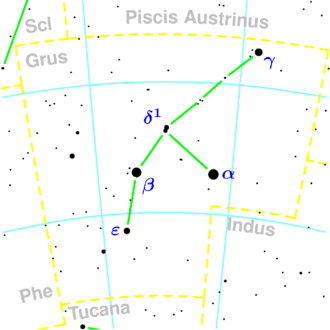NGC 7418
| Galaxy NGC 7418 |
|
|---|---|

|
|
| Photo from the Hubble Space Telescope | |
| AladinLite | |
| Constellation | crane |
|
Position equinox : J2000.0 , epoch : J2000.0 |
|
| Right ascension | 22 h 56 m 36.2 s |
| declination | -37 ° 01 ′ 48.3 ″ |
| Appearance | |
| Morphological type | SAB (rs) cd / HII |
| Brightness (visual) | 11.0 mag |
| Brightness (B-band) | 11.7 mag |
| Angular expansion | 3.5 ′ × 2.6 ′ |
| Position angle | 139 ° |
| Surface brightness | 13.2 mag / arcmin² |
| Physical data | |
| Affiliation |
IC 1459 group LGG 466 |
| Redshift | 0.004837 ± 0.000017 |
| Radial velocity | 1450 ± 5 km / s |
|
Stroke distance v rad / H 0 |
(65 ± 5) x 10 6 ly (19.9 ± 1.4) Mpc |
| history | |
| discovery | John Herschel |
| Discovery date | August 30, 1834 |
| Catalog names | |
| NGC 7418 • PGC 70069 • ESO 406-025 • MCG -06-50-013 • IRAS 22538-3717 • 2MASX J22563615-3701482 • SGC 225348-3717.8 • GC 4863 • h 3963 • HIPASS J2256-37 • LDCE 1547 NED003 | |
NGC 7418 is a bar-spiral galaxy with extensive star formation areas of the Hubble type SBc in the constellation Crane in the southern sky . The galaxy has an angular extent of 3.5 '× 2.6' and an apparent magnitude of +11.0 mag. It is an estimated 65 million light years away from the Milky Way and about 70,000 light years in diameter.
The galaxies NGC 7421 , IC 1459 , IC 5264 , IC 5273 are located in the same area of the sky .
The supernova SN 1983Z was observed here.
The object was discovered by John Herschel on August 30, 1834 .
Web links
Commons : NGC 7418 - collection of images, videos, and audio files
